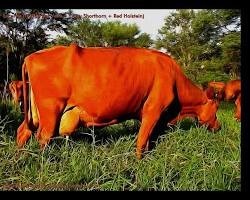 |
| Source: www.flickr.com |
The cross-bred local Criollo cattle of the Hartón del Valle breed with imported European-type dairy cattle of the Friesian and Milking Shorthorn breeds to create the Lucerna, the earliest composite breed developed in South America. By 1972, the composition of the breed had stabilized to 40% Friesian and 30% each of Hartón and Shorthorn. Since the mid-1950s, breeding has focused mainly on improving dairy qualities. In 1986, the Lucerna was present on only 15 farms, but by the end of the century, the number of farms tripled, reaching almost 3,000. In 2018, the total number of Lucerna cattle was reported as 1,028 head, and their conservation status was "not at risk." Some semen is stored for commercial purposes, not conservation.
Lucerna cattle are medium-sized, with cows standing 128 cm at the withers and weighing about 480 kg and bulls weighing about 700 kg on average. The coat is usually solid cherry-red, but it can vary. The average milk yield is over 2,000 kg in a lactation of around 300 days.
